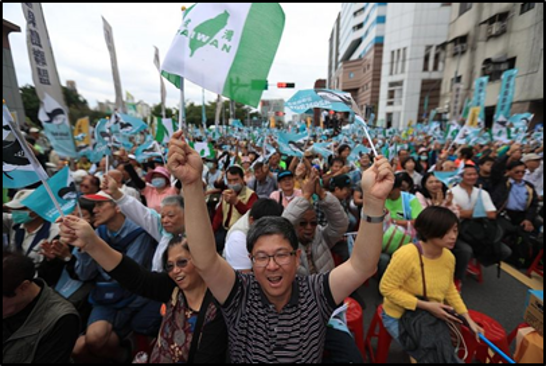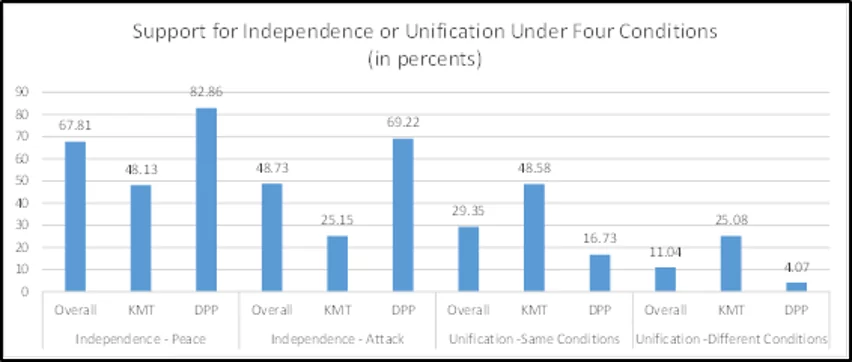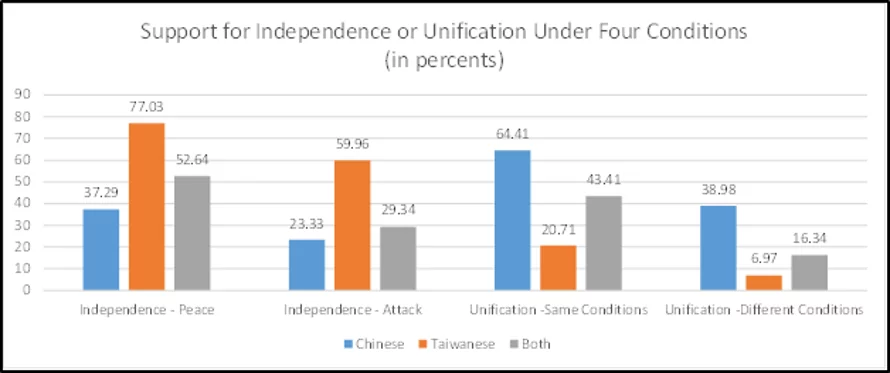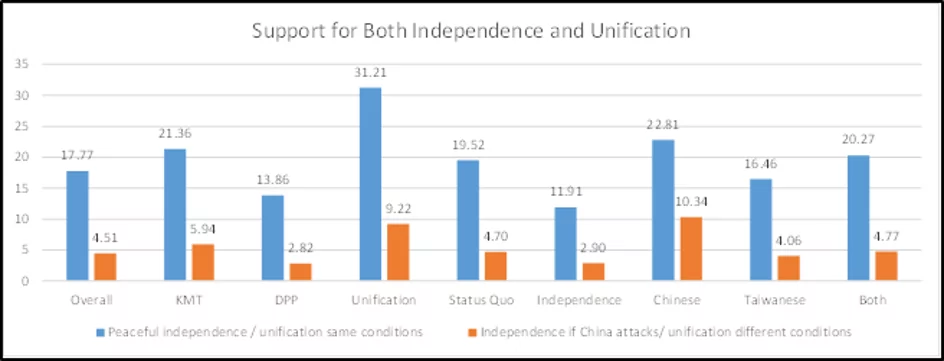
Taiwan Opinion Polling on Unification with China
Publication: China Brief Volume: 20 Issue: 18
By:

Introduction
The ill-defined sovereignty of Taiwan, which officially continues to exist under the political identity of the Republic of China (ROC), is often presented as a tension between two possible future outcomes: either unification with the People’s Republic of China (PRC), or formal independence. This ambiguous status quo not only allows Taiwan’s competing domestic supporters of unification or independence to believe in the possibility that their desired outcome could one day be attained, but has also led PRC officials to believe that widespread latent support for unification endures in Taiwan.
Beijing maintains that Taiwan is a province of the PRC, but its insistence on eventual unification contrasts with a growing sense of distinct Taiwanese identity on the island, as well as a declining sense of Chinese identity (The Asia Dialogue, February 8, 2019; Taiwan News, February 24). At the same time, an explicit move towards formal independence is constrained by the possibility of military conflict: without a guarantee of U.S. aid, it is unlikely that Taiwan’s smaller military could prevent a PRC victory in the event that the sovereignty dispute became violent. [1]
With the status quo in jeopardy, two polling questions are increasingly pertinent: 1) How do Taiwanese perceive prospects for strengthening relations with either the PRC or the United States; and 2) Do Taiwanese people support unification with the PRC, or do they support an independent Taiwan? Several factors must be considered in answering the first question, which encompasses the thorny issue of Taiwan sovereignty. Improved relations with the PRC would likely yield economic benefits for Taiwan, and could also de-escalate the diplomatic fight that has taken place globally over the issue of formal recognition of Taiwan. At the same time, many Taiwan officials and citizens are concerned that greater economic integration will ultimately serve the PRC’s longer-term goal of unification.
Strengthening relations with the United States would bolster Taiwan’s security. The United States is a major supplier of weapons to Taiwan, and the country most likely to come to its aid in the event of a mainland invasion. However, closer relations with the United States could also exacerbate tensions with the PRC, thereby endangering Taiwan. In the worst case scenario, closer ties between the United States and Taiwan could convince mainland Chinese officials to act on unification sooner, rather than later—before American commitments solidify.
New Polling Information from Taiwan Regarding Views on Unification
Often lost in this “China or America” debate is a clearer understanding of what citizens in Taiwan themselves prefer. Recently received survey data from the “Taiwan’s Election and Democratization Study” (台灣選舉與民主化調查, Taiwan Xuanju yu Minzhuhua Diaocha) (TEDS) project from Taiwan’s National Chengchi University sheds light on this. Between January 13th to May 31st, 1,680 respondents were asked their views as to how Taiwan’s relations with both the United States and the PRC should transition, on a scale ranging from -5 (further distance) to +5 (build closer ties) (TEDS, July 31; see below).
Figure 1: Support for Closer Relations with China or the United States, Broken Down by Party Lines
 Source: Compiled by the authors, based on TEDS data.
Source: Compiled by the authors, based on TEDS data.The new survey results show that Taiwanese generally want to maintain the status quo relationship with China (equivalent to a 0 on the scale), while desiring closer relations with the United States. However, clear partisan differences emerge. Kuomintang (KMT) supporters desired closer relations with both countries, favoring China over the United States. For their part, Democratic Progressive Party (DPP) supporters desired closer relations with the United States and greater distance from China (see below). Such partisan stances are consistent with the parties’ traditional positions on independence and unification issues. Additionally, a Pew Research poll earlier this year found that young Taiwanese prefer to prioritize U.S.-Taiwan economic relations (Pew Research Center, May 12).
Part of the desire for closer relations with the United States, especially among DPP supporters, is likely due to security concerns about Taiwan’s future. Research by Emerson Niou in 2004 suggested that public feelings for unification or independence remained unsettled: at that time, 46.38 percent of respondents indicated willingness to accept either outcome under ideal conditions—i.e., either peaceful independence, or unification under circumstances wherein both sides were politically and economically similar. [2] Such findings suggested that those who claimed to support the status quo in the early 2000s could be persuaded in favor of either unification or independence, depending upon circumstances. In the sixteen years since Niou’s survey, an increasingly distinct Taiwanese identity, and growing support for Taiwanese independence, have challenged this view of malleable support for the status quo.
Views on Independence or Unification Under Specific Circumstances
In the TEDS survey, respondents were asked the evaluate each of the following four statements on a four-point scale (from strongly disagree to strongly agree):
- If Taiwan could still maintain peaceful relations with the PRC after declaring independence, then Taiwan should establish a new, independent country.
- Even if the PRC decides to attack Taiwan after Taiwan declares independence, Taiwan should still become a new country.
- If the economic, social, and political conditions were about the same in both mainland China and Taiwan, then the two sides should unify.
- Even if the gap between the economic, social, and political conditions in mainland China and Taiwan is quite large, the two sides should still unify.
The figure below shows rates of support (agree/strongly agree) for each statement across the general population, broken down across the lines of Taiwan’s two main political parties. Across the entire population, more than two-thirds of respondents agreed that they would support independence if peaceful coexistence with China was a possibility. Among DPP supporters, peaceful independence elicits stronger agreement (82.86 percent), compared to less than half of KMT supporters (48.13 percent). All three polling populations indicated weaker support for the prospect of independence if China were to attack: a 69.22 percent majority of DPP supporters still supported independence under this scenario, compared to only 25.15 percent of KMT supporters and 48.73 percent of respondents overall.
Figure 2: Support for Independence or Unification Under Varying Conditions, Broken Down by Party Identification

Source: Compiled by the authors, based on TEDS data.
On the other hand, the data shows limited support for unification even under the “ideal conditions” of economic, social, and political conditions being the same in Taiwan and China (see below). Overall, less than a third of respondents (29.35 percent) supported unification under ideal conditions. KMT supporters were nearly evenly split, with 48.58 percent supporting unification under ideal conditions. Only 16.73 percent of DPP supporters were in favor of unification under ideal circumstances. Support for unification drops if framed under non-ideal conditions, wherein economic, social, and political differences between the two sides continue. Only 11.04 percent of respondents across the board supported unification with non-ideal conditions, with wide divergence between KMT supporters (25.08 percent) and DPP supporters (4.07 percent). It is worth noting that KMT respondents supported both ideal options (i.e., peaceful independence vs. unification under similar conditions) at nearly identical rates.
Support for Independence or Unification as Determined by Existing Preferences for Status Quo, Independence, or Unification
A majority of those supportive of the status quo (59.34 percent) and a supermajority of independence-minded respondents (84.43 percent) supported independence under ideal conditions. Surprisingly, 42.95 percent of respondents who said they supported unification also supported peaceful independence. Support dropped across all three groups (i.e., pro-status quo, pro-independence, or pro-unification) under circumstances in which independence would lead China to attack Taiwan. Only 32.04 percent of respondents overall were receptive to the idea of unification even under ideal conditions, compared to 78.23 percent of unification-minded respondents and a paltry 13.98 percent of independence-minded respondents.
Figure 3: Support for Independence or Unification Under Varying Conditions, Broken Down by Existing Preferences

Source: Compiled by the authors, based on TEDS data.
Figure 4: Support for Independence or Unification Under Varying Conditions, Broken Down by Sense of Identity

Source: Compiled by the authors, based on TEDS data.
Support for Independence or Unification Broken Down by Sense of National Identity
A clear majority of respondents who identify as Taiwanese support independence under peaceful conditions (77.03 percent), while a smaller majority (52.64 percent) of those identifying as both Chinese and Taiwanese support peaceful independence (see below). In contrast, only 37.29 percent of respondents identifying as Chinese support independence under peaceful conditions. Meanwhile, the majority of respondents identifying as Chinese support unification under ideal conditions (64.41 percent), compared to only 20.71 percent support from those identifying as Taiwanese, and 43.41 percent support from dual-identity respondents. Again, we see declines in support for both independence and unification under less than ideal conditions, although nearly 60 percent of those identifying as Taiwanese were still supportive of independence if China were to attack. More than one-third of those identifying as Chinese were still supportive of unification even if China and Taiwan did not have similar economic, political, and social conditions.
While a majority of Taiwanese support the ill-defined status quo for the time being (51.81 percent), it would be incorrect to assume that this ambiguity equates to respondents being open to both unification and independence, as they were in 2004. Only 17.77 percent of respondents overall were supportive of independence or unification under ideal scenarios (i.e., independence with peace, or unification with similar political and social conditions); within this 17.77 percent of respondents, the highest levels of support came from unification supporters (31.21 percent), Chinese identifiers (22.81 percent), and KMT supporters (21.36 percent). Meanwhile, only 11.91 percent of independence supporters, 13.86 percent of DPP supporters, and 16.46 percent of Taiwanese identifiers were supportive of both ideal conditions. Perhaps surprisingly, 19.52 percent of those that stated they preferred the continuation of the status quo indicated their support for both options, further suggesting that status quo supporters should not be viewed as indifferent or persuadable. Across every subgroup, joint support for independence and unification under less ideal conditions elicited far lower support.
Figure 5: Conditional Support for Both Independence and Unification

Source: Compiled by the authors, based on TEDS data.
Conclusion: What Does This Tell Us?
First, as Taiwanese identity grows over time and Taiwan’s democratic governance and liberal principles become a greater foil to the so-called “China model” of governance promoted by Beijing, support for Taiwan-centric actions (such as constitutional reform to change the country’s name) will likely continue to grow among the Taiwanese public (SCMP, May 25, 2019; Taiwan News, April 17; Taiwan News, July 22; Channel News Asia, September 2). These actions, while not explicit moves towards formal independence, are indicative of a decline in public support for unification.
Second, it will become harder for PRC officials to maintain the fantasy narrative of broad popular support in Taiwan for unification, and PRC disinformation campaigns targeting Taiwanese public opinion will likely be increasingly contested by independence-oriented politicians (SCMP, January 7; Recorded Future, April 29; IRI, August 25). With declining support for unification under any conditions, we may see a stronger push for more overt influence and disinformation campaigns from mainland China, which will risk exacerbating the sovereignty problem. Lastly, analysts should pay greater attention to interpreting Taiwanese public support for the status quo; and also to examining how the aforesaid “status quo” is defined in the popular consciousness. Rather than seeing support for the status quo as being equivalent to political indifference, the data collected by the TEDS poll instead suggests that many Taiwanese are hesitant to reveal their true preferences. For now, some Taiwanese may see the status quo as the most realistic option.
Moving forward, whether Taiwan pursues closer political and economic ties with the PRC or with the United States, these survey results suggest that the majority of KMT respondents will prioritize relations with China, consistent with their broader preferences for unification and desire to warm cross-strait relations to levels last seen under the Ma Ying-jeou administration. DPP supporters, concerned that closer relations with China may lead to unification by other means, will conversely continue to prioritize economic and political ties with the United States.
Ultimately, Taiwan can neither afford to ignore the competing interests of the PRC and the United States, nor the reality that improving relations with one will likely come at the expense of the other. Taiwan also cannot ignore the possibility that both sides may prioritize relations with each other at Taiwan’s expense. The U.S.-Taiwan relationship is currently experiencing a historic high, with the recent passing of the TAIPEI Act in the U.S. Senate and two high-level visits by senior U.S. officials. However, recent history has also shown the dangers that Taiwan faces—caught as it is in an ambiguous position of sovereignty, with its security in large part dependent on the greater U.S.-China relationship.
Timothy S. Rich is an associate professor of political science at Western Kentucky University and director of the International Public Opinion Lab (IPOL). His research focuses on public opinion and electoral politics, with a focus on East Asian democracies.
Andi Dahmer is a 2018 Harry S. Truman Scholar and a recent graduate of Western Kentucky University.
Notes
[1] See: David Pierson and Ralph Jennings, “To Stop a Chinese Invasion, Taiwan Needs a Stronger Military,” LA Times, October 6, 2020. https://www.latimes.com/world-nation/story/2020-10-06/china-taiwan-military-service.
[2] See: Emerson M.S. Niou, “Understanding Taiwan Independence and its Policy Implications,” Asian Survey vol. 44, no. 4, University of California Press, July/August 2004. https://www.jstor.org/stable/10.1525/as.2004.44.4.555.




